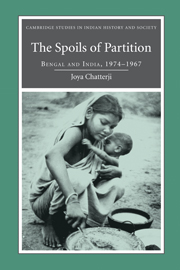Book contents
- Frontmatter
- Contents
- List of maps and illustration
- List of tables
- List of abbreviations
- Glossary
- Preface and acknowledgements
- Introduction
- Part I Hopes and fears
- 1 The devil in the detail: new borders for a new state
- 2 Swings and roundabouts: West Bengal and the new India
- Part II The Bengal diaspora
- Part III The politics of a partitioned state
- Conclusion
- Appendix
- Bibliography
- Index
2 - Swings and roundabouts: West Bengal and the new India
Published online by Cambridge University Press: 25 June 2009
- Frontmatter
- Contents
- List of maps and illustration
- List of tables
- List of abbreviations
- Glossary
- Preface and acknowledgements
- Introduction
- Part I Hopes and fears
- 1 The devil in the detail: new borders for a new state
- 2 Swings and roundabouts: West Bengal and the new India
- Part II The Bengal diaspora
- Part III The politics of a partitioned state
- Conclusion
- Appendix
- Bibliography
- Index
Summary
As India became independent and in Nehru's memorable words ‘awoke to life and freedom’, partition stripped it of 370,000 square miles of territory and 75 million people. A new state of Pakistan, consisting of Sind, Baluchistan, the North-West Frontier Province, the western Punjab, eastern Bengal and the district of Sylhet in Assam, was excised from British India (see map 2.1).
Partition had a profound impact on India. A definitive analysis of its consequences still awaits its historian, but two aspects require discussion here because of their impact on West Bengal. First, by jettisoning those parts of British India where Muslims were in a majority, independent India was able to construct for itself a unitary government with a robust centre. Secondly, the creation of Pakistan brought about a sea-change both in India's political geography and in the balance between its regions. These changes were reflected in the constitution drawn up by a fundamentally altered Constituent Assembly. Partition transformed the India inside which a new state of West Bengal had to fashion a place for itself.
That India would have a strong centre after partition was a foregone conclusion. The Congress had pressed for a limited partition in 1947 precisely in order to achieve a unitary state with a powerful central authority, and by accepting that demand, Attlee's announcement of June 3 cleared the way for the Congress high command to create for India the constitution it really wanted.
- Type
- Chapter
- Information
- The Spoils of PartitionBengal and India, 1947–1967, pp. 61 - 102Publisher: Cambridge University PressPrint publication year: 2007



